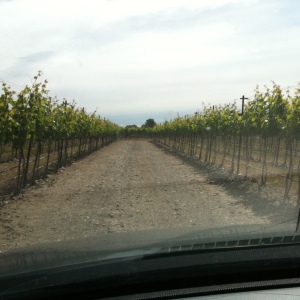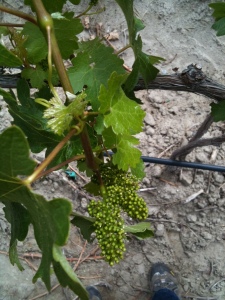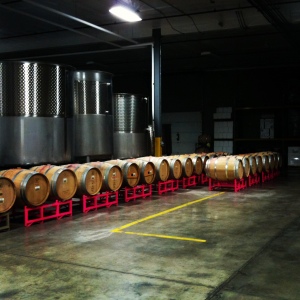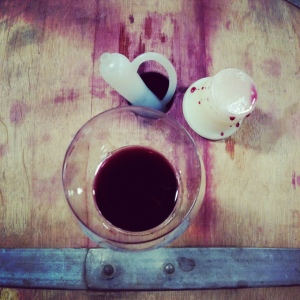Professor Sjolund, how do you make wine?
Last Saturday I took my “Wine Theory” class on a vineyard and winery tour. These people have been listening to me drone on and on for an entire school year about how to source grapes from the right locations, how and when to harvest grapes, how to ferment grapes into wine, how to blend wine, age wine, and bottle wine. Good grief…they should be sick of listening to it and talking about it by now. I know I would be…but I also have the patience of a nat. So in the interest of “connecting the dots,” and answer the proverbial question: “Professor Sjolund, how do you make wine?” I arranged a tour of two vineyard sites on Red Mountain, followed up by a tasting of the 2011 wines made specifically from those vineyards. The following captures my thoughts throughout the day:
As I drove through the vines into the middle of Scooteney Flats, I couldn’t help the silly grin that creased my cheeks. Have you ever arrived somewhere and just knew that you are in the right place at the right time? You stop and just…breathe. Every sense heightened, aware yet in awe, excitedly nervous, yet spiritually calm. That is how I feel every time I drive through a vineyard, or walk into a winery. I felt that way for the first time in August of 2000, standing at the entrance of a wine cave. That was the moment I officially decided to make this my career. The thrill of that moment, of that feeling, has never gone away to this day. It is that feeling that creases my cheeks, puts the sparkle in my eyes, and allows me talk about wine for hours on end. Dramatic I know, but it is why I do this for a living. At the very heart, it is passion. It is passion that drives me, and it is passion that I seek in those working with me. How do I teach that to a group of students wanting to know how I make wine? They have to find their own passion. All I can do is give them the opportunity, expose them to all of the elements, and give them the fundamental rope to start over the ledge.
Every winemaker has a “style,” a signature to their wines. People ask me what type of wines I make. My response: “I make the wines I like to drink.” Question: “How do you choose a vineyard that will give you the right kind of grapes to make the wines you like to drink?” Answer:”Start drinking other people’s wines. Find another wine producer you appreciate and respect, find out where their grapes come from, and pray that you know someone who knows someone.” It is all about making connections, putting your feet to the ground and seeking out those who can or will assist you. Once you find the source of the grapes you seek, it becomes imperative that you develop good communication with the grower. It is no coincidence we talk about “growing wine.” If the grower doesn’t know your style, how can they assist you in growing grapes for the wines you seek to make? It takes two to tango, so learn the dance. I like big, bold red wines with structure and balance. I look to Red Mountain vineyards for the backbone of my red wine blends. I look to the vineyard managers to help me achieve the balance I seek in the grapes they grow.
Each vineyard within an AVA like Red Mountain has its own personal characteristic. The soil, topography, and climate all play a role in how the grapes taste. The vineyard manager knows this as intimately as I know how the diversification of wine yeast and barrel selection can enhance the flavor and aroma of wine. Pictured above is what will become a cluster of Cabernet Sauvignon grapes from the Scooteney Flats vineyard on Red Mountain. This vineyard has 33 acres planted with all five Bordeaux varieties: Cabernet Sauvignon, Cabernet Franc, Merlot, Malbec, and Petit Verdot. The ground is composed of “scooteney” soil, which is identified as loess or alluvium over gravel. Loess soil is defined by Wikipedia as an “accumulation of wind-blown silt, twenty percent or less clay and the balance equal parts sand and silt that are loosely cemented by calcium carbonate.” What does this mean for grapes? It means that the soil is loose, or highly porous. Water and roots can penetrate the soil. Because it can develop thick layers, this soil will act like a sponge, allowing the vines to absorb nutrients and water. Even with natural rainfall and irrigation, the water will stay in the upper layers of the soil, never reaching the gravel unless fully saturated. Knowing this allows the vineyard manager better control over vine growth and irrigation. Knowing this as a winemaker allows for more interactive discussion with the vineyard manager regarding viticultural practices for that site. Nutrients in the soil impact the chemical composition of the fruit. The calcium coated gravel affects the pH of the fruit, which is something the winemaker has to deal with in the winery during fermentation and aging. Water impacts where the vine puts its growth energy (vegetative growth or fruit development). Too much water early grows large canopy’s, which decreases sunlight exposure, which leads to underripe “green” flavors in the fruit. Of course I am generalizing and oversimplifying here, but the point is that every decision in the field in addition to the site itself impacts how the fruit will taste. The winemaker has to care about this and understand it in order to make decisions regarding fermentation style and aging. One hand feeds the other. Know your vineyard manager. Bring them coffee at 6am when they are standing in the field waiting for daylight to harvest your grapes.
Once the grapes are harvested and the wine is made, you should invite your vineyard manager to taste the efforts of the season. As a winemaker, you must be able to distinguish the wine flavors coming from the fruit (vineyard), and those coming from fermentation and/or barrel selection (winemaking). If there were fermentation issues, or microbiological issues, did those originate in the vineyard or the winery? If the wine flavor and aroma is not expressive, is that a vineyard problem, or a winemaking problem? Use this information with your vineyard manager to make a strategy for next year. Scooteney Flats tends to produce very structured wines with what we describe as “chalky” tannin. You know that peanut butter effect when you eat too much and your mouth feels like the Sahara. It is a quality in red wine that I enjoy in small amounts. It has to be controlled. Overextraction during fermentation, and too much oak will send this wine right over the edge. You want to enhance the fruit, not overpower it. The grapes themselves expresses deep red and black fruits. The flavor intensity of the fruit can handle the tannin structure, but there has to be a balance. Of course barrels add a whole new dimension, and the exponential variables to winemaking go on and on from there. Point is this: know what the vineyard can give you, and know how to make it work for your style and palate. If it goes awry, figure out where the source of the problem is. Vineyard or winery? The best vineyards grow balanced expressive fruit that we as winemakers simply translate into drinkable form. The fruit requires minimal intervention on our part. In other words the vineyard manager will deliver the bins to the winery and shout “don’t screw it up” as they wave goodbye. Other vineyards require more manipulation and intervention to get what you want. Know the difference. Know when to back off, and when to intervene. This comes only from exposure and experience. You have to get out of the pick-up and walk the vineyard blocks. You have to be with that fermenter every day. You have to taste your wine. Know everything you can about it. That is the only way you can start to change it.
So back to the question: “Professor Sjolund, how do you make wine?” There is no simple answer to this. It depends on where the grapes come from. It depends on the composition of the soil, topography, and climate as to what kind of fruit the vineyard is going to give me. From there I make a decision on how to ferment that fruit in order to showcase the characteristics of its origin. Then I decide if it needs a barrel to enhance its flavor and structure. Even when dealing with the same vineyard year after year, each vintage is different. The earth provides a different set of circumstances every year, so my tactics are always changing. Cooperages are making different barrels, yeast strains are being sourced from different locations for better fermentation kinetics and flavor profiles, and the list goes on and on……it’s mind blowing. I’m very experimental with how I make wine. It is a personal challenge to raise the bar every year. Can I make the wine better than I did last year? What do I have to do to get there (wherever “there” is)? What am I doing right, and what needs to be tweaked? Is it viticultural or winemaking? The quest to make an “ideal” wine is a lifelong journey I am willing to take. That “ideal” exists only in my mind. The “ideal” is different for everyone. I hope I never get there, because then I would have to find something else to do. For it is the “ideal” that fuels the passion.
At the core of all this, there are fundamentals to winemaking. That is what I can teach you. It is the rope I can throw you as you dip your toes over the ledge before I push you. Beyond that, you must use your imagination and passion to navigate the terrain. Hold onto the rope with one hand, a foot, upside-down or sideways. The possibilities are endless. Fall off the rope, and you’ll need bandages. That is another blog post entirely.
Posted on June 12, 2012, in Uncategorized. Bookmark the permalink. Leave a comment.




Leave a comment
Comments 0